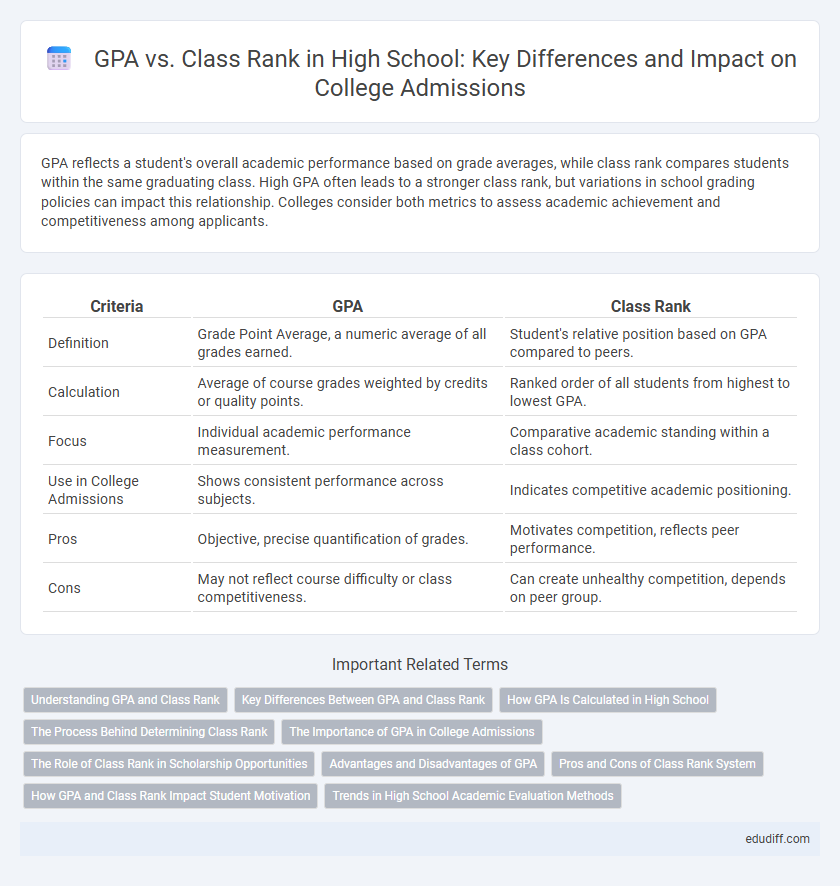GPA reflects a student's overall academic performance based on grade averages, while class rank compares students within the same graduating class. High GPA often leads to a stronger class rank, but variations in school grading policies can impact this relationship. Colleges consider both metrics to assess academic achievement and competitiveness among applicants.
Table of Comparison
| Criteria | GPA | Class Rank |
|---|---|---|
| Definition | Grade Point Average, a numeric average of all grades earned. | Student's relative position based on GPA compared to peers. |
| Calculation | Average of course grades weighted by credits or quality points. | Ranked order of all students from highest to lowest GPA. |
| Focus | Individual academic performance measurement. | Comparative academic standing within a class cohort. |
| Use in College Admissions | Shows consistent performance across subjects. | Indicates competitive academic positioning. |
| Pros | Objective, precise quantification of grades. | Motivates competition, reflects peer performance. |
| Cons | May not reflect course difficulty or class competitiveness. | Can create unhealthy competition, depends on peer group. |
Understanding GPA and Class Rank
GPA measures a student's average academic performance across all courses, calculated on a weighted or unweighted scale, reflecting overall achievement. Class rank compares a student's GPA to peers within the same grade, providing a relative position in the academic cohort. Understanding both GPA and class rank helps students gauge their academic standing and competitiveness for college admissions.
Key Differences Between GPA and Class Rank
GPA quantifies a student's average academic performance on a fixed scale, reflecting individual mastery of coursework, while class rank compares students relative to peers based on GPA distributions within the same grade. GPA serves as an absolute metric important for college admissions, demonstrating consistent achievement across subjects, whereas class rank highlights a student's standing by percentile, offering insight into competitive performance in a specific school environment. Understanding these differences helps students and educators evaluate academic success through both personal achievement and comparative positioning.
How GPA Is Calculated in High School
High school GPA is calculated by averaging the grade points earned in all completed courses, typically on a 4.0 scale where an A equals 4.0 and a B equals 3.0, with weight adjustments for honors or Advanced Placement classes. Each course grade is multiplied by its credit value, then the total grade points are divided by total credits to determine the cumulative GPA. This standardized numerical system provides a consistent measure of academic performance across different subjects and schools.
The Process Behind Determining Class Rank
Class rank is calculated by comparing students' GPAs within their grade level to establish their relative academic standing. Schools often weigh honors, AP, and IB courses more heavily when calculating GPA to reflect the rigor of coursework in class rank determination. This process helps universities assess students' performance in a competitive academic environment beyond raw GPA numbers.
The Importance of GPA in College Admissions
GPA serves as a critical metric in college admissions, reflecting a student's overall academic performance and consistency across courses. While class rank compares students within a specific school, GPA provides a standardized measure that colleges use to evaluate applicants nationwide. High GPA often opens doors to scholarships and competitive programs by demonstrating mastery of the curriculum and dedication to academic excellence.
The Role of Class Rank in Scholarship Opportunities
Class rank plays a critical role in scholarship opportunities by providing a comparative measure of a student's academic performance within their high school cohort. Many scholarships prioritize top percentile students, making a high class rank essential for eligibility and increased financial aid chances. While GPA measures overall academic achievement, class rank contextualizes it, influencing scholarship committees' decisions significantly.
Advantages and Disadvantages of GPA
GPA offers a standardized measure of academic performance across all subjects, allowing colleges to assess overall student achievement effectively. However, it may not accurately reflect a student's standing within their specific graduating class, potentially minimizing competitive context for college admissions. While GPA provides consistency, it can overlook the challenges of course rigor and individual class difficulty compared to class rank.
Pros and Cons of Class Rank System
Class rank provides a clear comparative measure of student performance within a high school, offering colleges insight into academic standing, but it may create unhealthy competition and stress among students. The system rewards consistent academic achievement relative to peers, yet it can disadvantage students from highly competitive schools where grades are more difficult to earn. While class rank helps identify top performers for scholarships and honors, it sometimes fails to reflect individual talents and growth beyond numerical grade comparisons.
How GPA and Class Rank Impact Student Motivation
GPA and class rank significantly influence student motivation by providing clear academic benchmarks that encourage goal-setting and competition among peers. High GPA often drives students to maintain consistent performance, while class rank fosters a sense of urgency and pride in academic standing within the school community. Both metrics shape students' study habits and involvement in extracurricular activities, directly affecting their long-term educational aspirations.
Trends in High School Academic Evaluation Methods
High schools increasingly emphasize GPA as a primary metric due to its detailed reflection of student performance across courses, surpassing the traditional class rank system that only indicates relative standing. Trends show a shift towards weighted GPA scales incorporating honors and Advanced Placement courses to better represent academic rigor. Schools adopt holistic evaluation methods, integrating GPA with class rank and extracurricular achievements to provide a comprehensive assessment for college admissions.
GPA vs Class Rank Infographic

 edudiff.com
edudiff.com